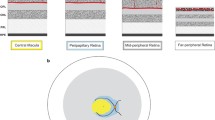Abstract
Mono- and bi-allelic mutations in the low-density lipoprotein receptor related protein 5 (LRP5) may cause osteopetrosis, autosomal dominant and recessive exudative vitreoretinopathy, juvenile osteoporosis, or persistent hyperplastic primary vitreous (PHPV). We report on a child affected with PHPV and carrying compound mutations. The father carried the splice mutation and suffered from severe bone fragility since childhood. The mother carried the missense mutation without any clinical manifestations. The genetic diagnosis of their child allowed for appropriate treatment in the father and for the detection of osteopenia in the mother. Mono- and bi-allelic mutations in LRP5 may cause osteopetrosis, autosomal dominant and recessive exudative vitreoretinopathy, juvenile osteoporosis, or PHPV. PHPV is a component of persistent fetal vasculature of the eye, characterized by highly variable expressivity and resulting in a wide spectrum of anterior and/or posterior congenital developmental defects, which may lead to blindness. We evaluated a family diagnosed with PHPV in their only child. The child presented photophobia during the first 3 weeks of life, followed by leukocoria at 2 months of age. Molecular resequencing of NDP, FZD4, and LRP5 was performed in the child and segregation of the observed mutations in the parents. At presentation, fundus examination of the child showed a retrolental mass in the right eye. Ultrasonography revealed retinal detachment in both eyes. Thorough familial analysis revealed that the father suffered from many fractures since childhood without specific fragility bone diagnosis, treatment, or management. The mother was asymptomatic. Molecular analysis in the proband identified two mutations: a c.[2091+2T>C] splice mutation and c.[1682C>T] missense mutation. We report the case of a child affected with PHPV and carrying compound heterozygous LRP5 mutations. This genetic diagnosis allowed the clinical diagnosis of the bone problem to be made in the father, resulting in better management of the family. It also enabled preventive treatment to be prescribed for the mother and accurate genetic counseling to be provided.


Similar content being viewed by others
References
Bianchi ML (2007) Osteoporosis in children and adolescents. Bone 41:486–495
Gong Y, Slee RB, Fukai N et al (2001) LDL receptor-related protein 5 (LRP5) affects bone accrual and eye development. Cell 107:513–523
Wan Y, Lu C, Cao J et al (2013) Osteoblastic Wnts differentially regulate bone remodeling and the maintenance of bone marrow mesenchymal stem cells. Bone 55:258–267
Mao J, Wang J, Liu B et al (2001) Low-density lipoprotein receptor-related protein-5 binds to Axin and regulates the canonical Wnt signaling pathway. Mol Cell 7:801–809
Xu Q, Wang Y, Dabdoub A et al (2004) Vascular development in the retina and inner ear: control by Norrin and Frizzled-4, a high-affinity ligand-receptor pair. Cell 116:883–895
Kato M, Patel MS, Levasseur R et al (2002) Cbfa1-independent decrease in osteoblast proliferation, osteopenia, and persistent embryonic eye vascularization in mice deficient in Lrp5, a Wnt coreceptor. J Cell Biol 157:303–314
Rehm HL, Zhang DS, Brown MC, Burgess B, Halpin C, Berger W, Morton CC, Corey DP, Chen ZY (2002) Vascular defects and sensorineural deafness in a mouse model of Norrie disease. J Neuroimmune Pharmacol 22:4286–4292
Richter M, Gottanka J, May CA, Welge-Lussen U, Berger W, Lutjen-Drecoll E (1998) Retinal vasculature changes in Norrie disease mice. Invest Ophthalmol Vis Sci 39:2450–2457
Lang R, Lustig M, Francois F, Sellinger M, Plesken H (1994) Apoptosis during macrophage-dependent ocular tissue remodelling. Development 120:3395–3403
Diez-Roux G, Lang RA (1997) Macrophages induce apoptosis in normal cells in vivo. Development 124:3633–3638
Lang RA (1997) Apoptosis in mammalian eye development: lens morphogenesis, vascular regression and immune privilege. Cell Death Differ 4:12–20
Lang RA, Bishop JM (1993) Macrophages are required for cell death and tissue remodeling in the developing mouse eye. Cell 74:453–462
Shastry BS (2009) Persistent hyperplastic primary vitreous: congenital malformation of the eye. Clin Experiment Ophthalmol 37:884–890
Ai M, Heeger S, Bartels CF, Schelling DK, Osteoporosis-pseudoglioma collaborative G (2005) Clinical and molecular findings in osteoporosis-pseudoglioma syndrome. Am J Hum Genet 77:741–753
Adzhubei IA, Schmidt S, Peshkin L, Ramensky VE, Gerasimova A, Bork P, Kondrashov AS, Sunyaev SR (2010) A method and server for predicting damaging missense mutations. Nat Methods 7:248–249
Saint-Geniez M, D’Amore PA (2004) Development and pathology of the hyaloid, choroidal and retinal vasculature. Int J Dev Biol 48:1045–1058
Toomes C, Bottomley HM, Jackson RM et al (2004) Mutations in LRP5 or FZD4 underlie the common familial exudative vitreoretinopathy locus on chromosome 11q. Am J Hum Genet 74:721–730
Fei P, Zhang Q, Huang L et al (2014) Identification of two novel LRP5 mutations in families with familial exudative vitreoretinopathy. Mol Vis 20:395–409
Jiao X, Ventruto V, Trese MT, Shastry BS, Hejtmancik JF (2004) Autosomal recessive familial exudative vitreoretinopathy is associated with mutations in LRP5. Am J Hum Genet 75:878–884
Acknowledgments
We wish to thank this family for their help and patience, Ms. Angelique Schmid, Mr. Yann Leuba, and Mr. Cédric Schöpfer for their technical help, and Ms. Susan Houghton for editing the manuscript.
Conflicts of interest
None.
Ethical approval
The study was performed in adherence to the tenets of the Declaration of Helsinki and the parents authorized this publication.
Author information
Authors and Affiliations
Corresponding author
Additional file
Below is the link to the electronic supplementary material.
Additional file 1: Table S1
Sequences of PCR primers.
Rights and permissions
About this article
Cite this article
Kheir, V., Munier, F.L., Aubry-Rozier, B. et al. Potential blindness in children of patients with hereditary bone disease. Osteoporos Int 27, 841–844 (2016). https://doi.org/10.1007/s00198-015-3245-4
Received:
Accepted:
Published:
Issue Date:
DOI: https://doi.org/10.1007/s00198-015-3245-4




